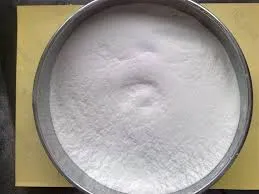
Dec . 03, 2024 17:44 Back to list
what does hpmc stand for
Understanding HPMC What Does It Stand For?
HPMC, or Hydroxypropyl Methylcellulose, is a non-ionic cellulose ether that has garnered significant attention in various industries due to its unique properties and versatile applications. This compound is derived from cellulose, which is a natural polymer obtained from plant materials. By modifying cellulose through the addition of hydroxypropyl and methyl groups, HPMC is created, resulting in a semi-synthetic product that combines the beneficial characteristics of cellulose with improved performance attributes.
Composition and Properties
HPMC is praised for its remarkable solubility and rheological properties. It is commonly found in powder form and can dissolve in cold water, forming a gel-like consistency. This solubility makes it a valuable ingredient in a wide array of formulations. The degree of substitution of hydroxypropyl and methyl groups in HPMC can be tailored during production, leading to variations in viscosity, solubility, and thermal properties. These customizable features allow manufacturers to select the specific type of HPMC best suited for their applications, whether in pharmaceuticals, food, cosmetics, or construction.
Pharmaceutical Applications
One of the most significant applications of HPMC is in the pharmaceutical industry. It serves primarily as a binder and thickening agent in tablet formulations. Its ability to form gels and control drug release makes HPMC an ideal choice for controlled-release formulations. Moreover, it is often used in ophthalmic preparations due to its compatibility with the human system and its ability to enhance the viscosity of solutions, allowing for a prolonged retention time in the eye. Furthermore, HPMC is non-toxic and does not exhibit allergenic properties, making it safe for use in various drug products.
Food Industry Uses
what does hpmc stand for

In the food industry, HPMC is frequently used as a food additive, designated with the E number E464. It serves multiple purposes, including acting as a thickener, emulsifier, and stabilizer in various food products. HPMC helps improve the texture and mouthfeel of processed foods, while also enhancing the shelf life by preventing moisture loss. It is commonly found in sauces, dressings, baked goods, dairy products, and gluten-free items, where it helps mimic the texture associated with gluten.
Cosmetic and Personal Care
HPMC's applications extend into the cosmetic and personal care industries as well. Its film-forming, thickening, and stabilizing properties make it a popular ingredient in lotions, creams, shampoos, and other formulations. HPMC helps to improve the overall texture and effectiveness of these products, promoting better spreadability and a pleasing feel on the skin. As consumers increasingly seek products that are both effective and contain natural ingredients, HPMC’s plant-based origins position it favorably in the market.
Construction Applications
Another notable area where HPMC is utilized is in construction, particularly in dry mix mortars and adhesives. It enhances the workability and adhesion properties of these materials, ensuring better application and performance. HPMC improves the water retention of mortar mixtures, allowing for better curing and preventing premature drying, thereby strengthening the final product. Its adaptability and effectiveness make it a staple in modern building materials.
Conclusion
In summary, HPMC stands for Hydroxypropyl Methylcellulose, a multifunctional compound with a broad range of applications across numerous industries. Its unique properties, derived from its cellulose-based structure, allow it to serve as a vital component in pharmaceuticals, food products, cosmetics, and construction materials. As industries continue to innovate and pursue natural, safe, and effective ingredients, HPMC is likely to remain a critical ingredient that meets these demands. Understanding HPMC's versatility not only sheds light on its importance but also opens the door for future developments in product formulation and application across various sectors.
-
Versatile Hpmc Uses in Different Industries
NewsJun.19,2025
-
Redispersible Powder's Role in Enhancing Durability of Construction Products
NewsJun.19,2025
-
Hydroxyethyl Cellulose Applications Driving Green Industrial Processes
NewsJun.19,2025
-
Exploring Different Redispersible Polymer Powder
NewsJun.19,2025
-
Choosing the Right Mortar Bonding Agent
NewsJun.19,2025
-
Applications and Significance of China Hpmc in Modern Industries
NewsJun.19,2025







